Is Tracheostomy Tube Placement in Preemies Safe?
Is Tracheostomy Tube Placement in Preemies Safe? https://pediatricsnationwide.org/wp-content/uploads/2021/02/022812ds391HRBW_NICU-for-web-header-1024x575.gif 1024 575 Mary Bates, PhD Mary Bates, PhD https://secure.gravatar.com/avatar/c6233ca2b7754ab7c4c820e14eb518c8?s=96&d=mm&r=g- October 06, 2021
- Mary Bates, PhD

The procedure is safe and effective in newborns requiring high ventilator pressures.
Tracheostomy tube placement is a common procedure performed for premature infants requiring respiratory assistance. Compared to an endotracheal tube, placement of a tracheostomy tube is thought to allow the infant more opportunities for comfort, interaction, nutrition and growth.
However, rates of tracheostomy tube placement vary across centers. One reason is the assumption that newborns requiring high ventilator pressure will have higher complication rates during and after tracheostomy tube placement.
According to Edward Shepherd, MD, section chief of Neonatology at Nationwide Children’s Hospital, this results in a Catch-22.
“The kids who really need the tracheostomies are the kids who require a lot of ventilator support, and the reason they need the tracheostomies is because they require a lot of ventilator support,” he says.
The Comprehensive Center for Bronchopulmonary Dysplasia at Nationwide Children’s is a standalone, referral-based unit devoted to the care of premature infants with respiratory difficulties and has extensive experience placing tracheostomy tubes in infants, even those requiring high ventilator settings.
In an effort to determine whether tracheostomy placement in infants requiring high ventilator pressure is safe and effective, Dr. Shepherd and his colleagues recently compared short-term outcomes of tube placement in infants with low versus high ventilator pressures.
The researchers analyzed the records of 50 infants under 1 year old who underwent tracheostomy tube placement at Nationwide Children’s Newborn Intensive Care Unit between 2009 and 2018. They compared outcomes of patients requiring high ventilator pressures to those requiring low ventilator pressures over the seven days after tube placement.
“We were pleasantly surprised to see that there were no clinically significant differences between the two groups; everybody did just fine with the procedure,” says Laura Banks, a student researcher in the departments of Otolaryngology and Neonatology and co-author of the study, which was published in Otolaryngology Head & Neck Surgery.
The analyses showed no intraoperative complications or deaths within the first seven days of tracheostomy tube placement in either group. Incidence of pneumonia and rate of mortality during admission were also similar in the two groups.
“These data provide evidence that placement of tracheostomy tubes in patients requiring high ventilator pressures is feasible and safe, with no additional short-term risks,” says Banks.
Dr. Shepherd, who is also an associate professor of clinical pediatrics at The Ohio State University College of Medicine, says this study validates the practices at Nationwide Children’s.
“We are known for our willingness to provide whatever support a baby might need, even if that means very high ventilator settings, much higher than most centers go,” he says.
“Our hope is, through publishing a study like this, other centers will feel more comfortable in providing that level of support to these babies.”
This article appears in the 2021 Fall/Winter print issue. Download the full issue.
Reference:
Banks L, Worobetz N, Hamersley E, Onwuka A, Shepherd E, Wiet G. Evaluation of short-term outcomes of tracheostomy procedures in a NICU population with high ventilator settings. Otolaryngology Head and Neck Surgery. 2021 Mar 9:194599821996226. [Epub ahead of print]
Image credit: Nationwide Children’s
About the author
Mary a freelance science writer and blogger based in Boston. Her favorite topics include biology, psychology, neuroscience, ecology, and animal behavior. She has a BA in Biology-Psychology with a minor in English from Skidmore College in Saratoga Springs, NY, and a PhD from Brown University, where she researched bat echolocation and bullfrog chorusing.
-
Mary Bates, PhDhttps://pediatricsnationwide.org/author/mary-bates-phd/December 27, 2016
-
Mary Bates, PhDhttps://pediatricsnationwide.org/author/mary-bates-phd/
-
Mary Bates, PhDhttps://pediatricsnationwide.org/author/mary-bates-phd/
-
Mary Bates, PhDhttps://pediatricsnationwide.org/author/mary-bates-phd/






